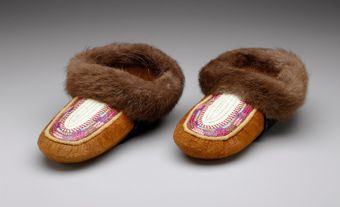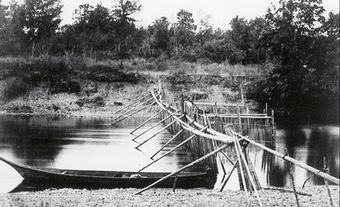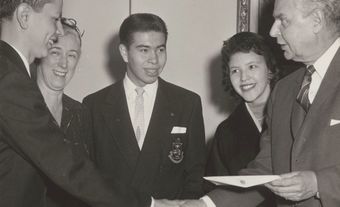The term “Subarctic Indigenous peoples” describes a number of different ethnic and linguistic groups, including the Dene, Cree, Ojibwe, Atikamekw, Innu and Beothuk. The Subarctic region consists largely of a five million square kilometre zone of boreal forest extending from the arctic tundra south to the mountains, plains and deciduous forest in the mid-section of the country. West to east, it extends from the Bering Sea to Labrador. The Subarctic is one of six cultural areas contained in what is now Canada. Unlike provinces and countries, these cultural areas do not have strict boundaries, and instead refer to areas in more general terms.

Geography
While parts of the Subarctic region extends into the Arctic, three-quarters of the area lies on the Canadian Shield, Hudson Bay and Mackenzie River lowlands. It is dotted with many lakes and crossed by innumerable rivers, and consists of western mountain ranges, plateaus and the Yukon River lowlands.
Resources
Indigenous peoples in the Subarctic used animals like moose, caribou, black bear, Dall sheep (northwestern mountains), beaver, hare, marmot and groundhog for materials and subsistence. Wolverine, otter, marten, mink, weasel, muskrat, lynx, wolf, coyote, fox and others, together with some of the subsistence species, provided furs for trade. ( See also Fur Trade in Canada.) Muskox, bison and wapiti were also available but less common. Fish are abundant in the rivers and lakes, and include several species of whitefish, pike, lake trout, grayling and suckers in the Arctic, salmon in the Pacific regions and, to a lesser extent, Atlantic regions. Migratory waterfowl pass through the Subarctic seasonally.
Major Indigenous Groups and Languages
Most Indigenous peoples in the Eastern Subarctic belong to the Algonquian language family, while those of the Western Subarctic are generally part of the Athapaskan (also known as Dene) family. Northern Subarctic Algonquian peoples, including the Atikamekw and Innu of Québec and Labrador, speak Cree dialects, and Algonquian to the south speak Ojibwe dialects. (See also Cree Language and Anishinaabemowin: Ojibwe Language.) The Beothuk spoke a language of uncertain affinity. Linguists have identified more than 20 different Northern Dene languages within the Western Subarctic, including Alaska. (See also Indigenous Languages in Canada.)
Most Indigenous people of the Subarctic were organized into bands or groups of people who spoke the same language and were related by kinship and common traditions. Within each of the two major language families, neighbouring groups often shared similar ways of life. Perhaps because the Western Subarctic is physically more diverse than the east, there was more linguistic and cultural diversity among the Dene than the Algonquian peoples. Dene, which means “people,” is commonly used to refer to Athapaskan speakers, as well as the Dene Nation.
Dene groups in the Subarctic area include the Dene Nation (Tlicho, Chipewyan, Gwich’in, Dene Tha' & Dehcho, Sahtú), Tlingit, Tagish, Tahltan, Tutchone, Kaska, Han, Tsetsaut, Sekani, Dane-zaaand T'atsaot'ine, while Algonquian groups include the Ojibwe, Cree, Atikamekw, Innu and Beothuk.
Traditional Practices
Indigenous peoples in the Subarctic lived by hunting, fishing, trapping and gathering wild plants. Farming was not practical within their territory; crops successfully grown in the North today did not reach neighbouring areas until after European contact. Men did most of the big-game hunting, while women snared hare, fished, cut and dried meat, and processed hides. Some hunting techniques such as drives that forced animals into temporary corrals would involve most adult members of a band.
Hunting implements included bows, arrows, a variety of traps, snares, deadfalls, and such devices as the caribou drift fence and pound. People caught fish with dip and gill nets, traps, spears, and hook and line. They dried berries in the fall or stored them in baskets in pits in the ground. In the northwest, berries were often mixed with fat and fish, or were mixed with pounded dried meat and grease to make pemmican. Women were skilled in preparing meat for drying, hide tanning and sewing, making cooking and storage containers of skins, birchbark or coiled spruce root basketry, as well as fishnets from willow baste or babiche.
Since game animals were thinly distributed over vast territories in the boreal forest, or were available only locally or seasonally, population densities were modest. Some scholars estimate that the entire area may have supported as few as 60,000 people, although others believe that before the introduction of European diseases, populations could have been larger. (See also Epidemics in Canada.)
Social Organization
Subarctic Indigenous peoples typically lived in communities of 25-30 people. Each group moved frequently within a well-defined territory as game supplies changed from season to season and from year to year. A group's size and the nature of its annual economic cycle were strongly influenced by the availability of local resources. The Tutchone, Dene of the Yukon Plateau, and others west of the Rocky Mountains, gathered along rivers during the summer to catch and dry salmon. The Chipewyan and Dene living north of Lake Athabasca, moved to the edge of the barren grounds to follow the caribou herds. Innu spent their summers near the Atlantic, Gulf of St Lawrence or James Bay coasts and moved inland during the winter. The Dane-zaa hunted bison on the parkland adjacent to the Peace River and used controlled burning to maintain the animals’ habitat.
A single band rarely had exclusive access to its territory since adjacent bands frequently shared hunting resources, especially if they faced food scarcity. Sharing resources rather than the accumulation of wealth was emphasized among individuals and communities because it provided collective insurance against shortages. However, rich sites such as lakes or rivers where fish could be taken regularly were usually exploited by the same band year after year. During the summer, when food was abundant, several local bands often resided together.
Most Subarctic bands did not have formal chiefs before European contact. People aligned themselves with individuals who manifested leadership and took the responsibility for specific tasks such as trading, war or communal hunting. Aside from the prestige and respect this brought them, their authority did not generally extend beyond these tasks. European fur traders, however, attempted to establish chiefs and to endow them with considerable power, in order to have better control of the Indigenous population associated with trading posts.
Most adult men and women participated in decisions that affected the band. Families or individuals who did not agree with a particular decision were free to join another band or camp, or to act on their own for a time. Subarctic people were noted for the value they placed on personal autonomy as well as for the flexibility of their social organization. These characteristics helped them respond to the opportunities and limitations of their environment.
Kinship ties among Subarctic peoples could be passed through the mother (matrilineal), father (patrilineal) or both (bilateral). Matrilineal kinship ties existed among Pacific coast region Dene, bilateral ties were characteristic of the people of the Mackenzie River region, and both bilateral and patrilineal bonds united the Algonquian speakers. Normally, people who had regular contact used kinship terms, in part structured according to generation (e.g., the eldest people become grandfather or grandmother), to address and refer to one another. Kinship relations often determined membership in groups and regulated marriages. In addition, groups west of the Mackenzie River were organized into clans, and also in some cases by dual divisions (moieties) similar to those ofWest Coast Nations. These divisions served primarily to ensure hospitality and protection to clan members who might be visiting from other camps or bands, to fulfil certain ceremonial obligations (e.g., cremation and/or burial of the dead and reciprocal feasts) and to regulate marriage through a requirement to marry outside of the clan.
Since subsistence necessitated mobility, Indigenous peoples in the Subarctic had limited material possessions. They travelled lightly and preferred to make heavier tools and implements as they were needed rather than carry them from place to place. Success in hunting depended on accurate knowledge of animal behaviour. They taught children to be self-reliant, observant and resourceful and were expected to learn the habits of game animals and to find their way through large areas of difficult terrain. They learned these skills by listening to long hours of practical narrative accounts and mythological tales and by rehearsing special trapping and hunting songs and innumerable riddles. Among many groups, both boys and girls were sent on vision quests to obtain power from animal helpers or the spirits of natural places. Individuals who were successful hunters were acknowledged to have gained the respect and trust of the animals.

Material Culture
People of the northern forests made summer moccasins, leggings, shirts and coats of soft tanned hides. Unique among the Pacific drainage Dene was the short V-tailed summer slipover caribou skin tunic, highly ornamented with dyed porcupine quills, dentalia (animal teeth) and beads made from seeds (later glass, trade beads). This shirt was sometimes worn with leggings and with moccasins attached. More generally, Subarctic Indigenous peoples wore relatively light clothing and built fires whenever they stopped. Winter sleeping robes were made of rabbit skins cut into strips, twisted and woven together.
Men made snowshoes, toboggans, canoes, sleds and hunting implements. Survival depended on being able to travel long distances. Snowshoes were essential for winter travel. Heavy loads were transported on toboggans and, in the far northwest, sleds were pulled both by dogs and people. During the summer, people travelled with their belongings in canoes on rivers and lakes.
Because of their mobile existence, northern forest peoples built shelters constructed of easily transported skin covers and of locally available materials such as bark. Dwellings varied considerably depending on local materials and traditions, but in all areas they were designed to be heated and lit by a single fire. They did not usually accommodate more than two families. Among the northern Ojibwe, dwellings were ridge pole or conical lodges also covered with birchbark. Wigwams were common among Algonquian peoples. Many of the Arctic drainage Dene lived in conical shelters covered with hides, similar to the tipi, which was the typical dwelling of Plains people. Among the Gwich'in and Han of the Yukon, as well as in northern Alaska, the conical tent was replaced by a domed or hemispherical one. Double lean-to structures covered with hides and brush were also used in the Arctic (Mackenzie) region and the northwestern mountain and plateau regions.
At fishing camps in the Cordillera there were unchinked "smokehouses" that resembled roughly-built log cabins. To provide added warmth in winter dwellings, the hair was left on the hide coverings of conical and domed tents which, although bulky, were nevertheless portable. Some Dene of the Mackenzie District and Cordillera as well as eastern Subarctic peoples wintered in conical log structures chinked with moss and partially covered with dirt and snow. The Han near Dawson, as well as many Alaskan groups, built rectangular pit houses that were heavily banked with turf to withstand the cold, while far to the south in British Columbia, groups such as the Tsilhqot'in made pit houses similar to those used by the peoples of the Plateau.
Considerable effort was taken to cache food and equipment not needed for the season; specially prepared pits, strong cribbed and conical structures, cairns, or racks and platforms in trees were used for storage.
Spirituality
Oral histories described a time when animals had great power and could assume human form. Many Subarctic peoples told stories about a "culture hero," the first person to gain special powers. For them, power and knowledge were one, and a powerful individual was one who "knows something." The culture hero demonstrated the personal knowledge and self-reliance recognized as important survival skills, and could outwit individuals with knowledge of evil medicine. They also possessed the ability to overcome dangerous animals, and thus made the world a safer place in which humans could live. The Algonquian culture hero and trickster figures are known as Nanabozo and Wisakedjak. The Dene culture hero goes by many names but is often associated with migratory water birds and the sun, both of whom are seen to fly through the heavens. Beliefs about the interdependence of people and nature embodied in oral histories helped Subarctic Indigenous peoples interpret their environment.
Spiritual leaders were people who used their powers for the benefit of others, though to some people did not. Among many Algonquians, these shamans, or medicine people, conducted the Shaking Tent ceremony in which distant spirits of people or animals were conjured for curing and prophecy in a special tipi. Elsewhere, shamans performed under a blanket or dressed in a special manner, signifying their importance within the community. Western Dene medicine men and women charged high prices for their services and asserted prerogatives or took liberties among their people, meaning many of them were feared as well as respected. Among the Innu, certain men and women predicted hunting trails by scapulamancy, a form of divination which interpreted the pattern of cracks on a caribou shoulder blade heated by fire.
The Dane-zaa of the Peace River region in the West had prophets called Dreamers, people who had experienced death and flown like swans to a spirit land beyond the sky. They were healers and leaders in religious dances based on songs they brought back from their journeys to heaven. Like many other Subarctic peoples, they sang to the accompaniment of single-headed hand drums. Most people, however, had some degree of medicine power obtained from childhood vision quests. In addition, there was a body of beliefs and practices, taboos, prescriptions and minor rituals separate from shamanism, divination and curing.
Contact with Europeans: Cultural and Environmental Change
Contact with Europeans brought intense and irrevocable change to Indigenous peoples in the Subarctic. Many quickly became dependent on the fur trade for goods like guns, knives, axes, cooking pots and clothing. Eventually they became dependent on trade for food, as they had turned from harvesting animals for food and skins to trapping those species desired by European markets. Bands moved closer to trading posts, and traders worked to exert control over the Indigenous peoples. Trading chiefs who negotiated with the Europeans became as important as the earlier hunting leaders.
The fur trade had considerable impact on Subarctic ecology. Many species of game and fur-bearing animals became depleted. European diseases such as smallpox, tuberculosis, measles and influenza killed large numbers of Indigenous peoples. (See also Health of Indigenous Peoples in Canada.) Others died of starvation during periods of disease and game scarcity.
Early contact during the 17th century caused extensive migration of Subarctic peoples, namely with groups such as the Cree, and brought new and diverse intertribal relationships.
The 19th century was characterized by direct contact between Indigenous peoples and Europeans engaged in the fur trade. Different bands experienced the effects of contact with greater or lesser consequences. In Newfoundland, loss of habitat and killing by Europeans led to the complete dispersal of the Beothuk by 1829.
By contrast, the neighbouring Innu developed a trapping economy and systematic trade relations with Europeans. They initially successfully adapted to contact conditions because Europeans required furs and did not immediately claim Innu hunting territories. Later, the federal government forcibly relocated Innu into permanent settlements in an effort to assimilate them into the global wage economy, often with disastrous social consequences.
Other Indigneous groups such as the Cree became fur-trade middlemen between the Hudson's Bay Company (HBC) and Dene to the west. Following Alexander Mackenzie's voyages of exploration along the Peace and Mackenzie rivers beginning in 1789, the rival North West Company (NWC) established trading posts that gave traders direct contact with the Dene. In 1821, these posts were taken over by the HBC, which became an important influence in the area.
European missionaries and forced participation in the assimilative, destructive, and abusive residential school program led many Subarctic Indigenous peoples to forcibly adopt elements of Christianity. Some managed to retain many of their own spiritual traditions, sometimes blending the two.
Contemporary Life: Land Claims and Developments
During the 20th century, resource development in the North and movement of non-Indigenous peoples into the Subarctic dramatically increased. These conditions motivated contemporary Subarctic Indigenous peoples to press for land claims settlements and increased control over their communities, culture and future. After decades of marginalization and exclusion from self-determination, many groups have successfully negotiated land claims and self-government agreements within the Canadian national context. However, many communities still suffer from poor social conditions and other challenges. (See also Social Conditions of Indigenous Peoples in Canada.)
Large-scale resource development and settlement of the North have threatened the traditional Indigenous economy of trapping and subsistence hunting. In 1975, the Grand Council of the Cree signed the James Bay and Northern Québec Agreement accepting compensation for social and ecological impacts of the James Bay Hydroelectric Project. Many people continue to hunt and trap on their land, using government entitlements to subsidize the cost of modern transportation and communication systems.
Oil and gas exploration has caused dramatic environmental impacts in the Peace River areas of British Columbia and Alberta. The massive development of the tar sands in the Fort McMurray region has caused even greater impact to the Cree of northern Alberta. Some First Nations have received benefits in the form of jobs and compensation from developers, but environmental changes have severely impacted traditional hunting, fishing and trapping activities, which in turn have resulted in protests and a tense political climate. For example, the Mikisew Cree First Nation and Athabasca Chipewyan First Nation, both based in Fort Chipewyan, Alberta, have advocated against oil sands development, arguing it infringes upon Indigenous rights and damages the environment.

 Share on Facebook
Share on Facebook Share on X
Share on X Share by Email
Share by Email Share on Google Classroom
Share on Google Classroom










